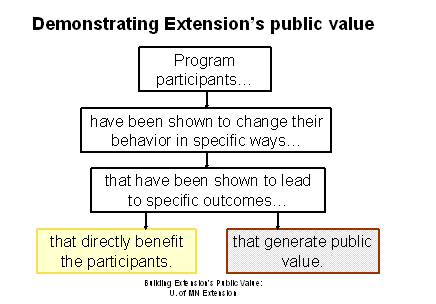Last week I gave a brief talk about “Building Extension’s Public Value” at a meeting of the Outreach and Engagement Leadership Group of Oregon State University Extension. An interesting question came up with regard to the slide I use to describe the elements of a public value message (below):
I always describe the lower right box (the maroon/pink box) as including any of the sources of public value: narrowing an information gap, addressing a concern about fairness or justice, encouraging public benefits, and discouraging public costs. A conference participant asked if the schematic could be used to explain how an Extension program addresses a stakeholder’s concern, even if that concern is not necessarily related to the common good. One would think of the maroon box as representing “stakeholder value,” rather than public value, and it could include anything that the stakeholder cares about. For example, if an Extension program team is seeking funding for a program from a corporate sponsor, they could demonstrate that the behavioral changes and outcomes of the program lead to increased customer share (or profits, or visibility, or whatever the cponsor cares about) for the corporation. The message would be, “If you sponsor our program, you will enjoy a larger customer share.”
In a sense, the public value approach already does this,whether our sponsor is in the public, nonprofit, or private sector. We try to determine what the sponsor cares about, and see how our mission coincides with theirs. By identifying and communicating the public value of the program, we are also showing how our program addresses the sponsors concerns. For example, consider a granting entity whose primary concern is local economic vitality. We use our public value message to explain how, when participants complete our program, they make behavior changes that enliven the local economy–which both generates public value (everyone in the local region benefits) and contributes directly to the sponsor’s mission.
I would not go so far, though, as to replace the “public value” box in the above diagram with a “stakeholder value” box. As long as our programs are at least partially funded by taxpayer contributions, whether from state, country, or federal taxes, I think we need to focus on the value we create for the general public. We wouldn’t want to alter our programs to serve the interests of sponsors at the expense of the public good. I think the focus should still be on how the public value that a program generates conincides with the interests of a potential sponsor.
What do you think?
